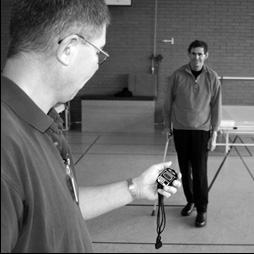 Assessment of the walking ability of patients with movement disorders is an important outcome measure in rehabilitation. Valid and reliable walking tests that quantify gait performance allow therapists to evaluate the development of the patient's walking ability throughout his/her rehabilitation. "Valid" refers to the ability of an instrument in assessing what it is intended to measure; "reliable" refers to the reproducibility of measurements that is, to what extent replicated measurements agree. Several timed walking tests have been developed for this purpose. The validity and reliability of these tests have been investigated in several populations, varying from healty elderly people to patients with stroke, Parkinson's disease or lower-limb ampution.
Assessment of the walking ability of patients with movement disorders is an important outcome measure in rehabilitation. Valid and reliable walking tests that quantify gait performance allow therapists to evaluate the development of the patient's walking ability throughout his/her rehabilitation. "Valid" refers to the ability of an instrument in assessing what it is intended to measure; "reliable" refers to the reproducibility of measurements that is, to what extent replicated measurements agree. Several timed walking tests have been developed for this purpose. The validity and reliability of these tests have been investigated in several populations, varying from healty elderly people to patients with stroke, Parkinson's disease or lower-limb ampution.
In patients with a spinal cord injury (SCI), 2 walking tests have been validated: the Spinal Cord Injury-Functional Ambulation Inventory and the Walking Index for Spinal Cord Injury (WISCI), which was revised later in the WISCI II.
The WISCI II has an original scale that quantifies a patient's walking ability; a score of 0 indicates that a patient cannot stand and walk and the highest score of 20 is assigned if a patient can walk more than 10m without walking aids of assistance. We introduced this test, together with 3 timed walking tests, in our SCI center. The timed walking test are Timed Up & Go (TUG) test, 10-meter walking test (10MWT), and the 6-minute walk test (6MWT). The TUG measures the time (in seconds) it takes a patient to stand up from an armchair, walk 3m, return to the chair, and sit down.
This test was originally developed as a clinical measure of balance in elderly people. The 10MWT measures the time (in seconds) that it takes a patient to walk 10m; it assesses the short duration walking speed. This test has been used in gait studies of patients with neurologic movement disorders in general, as well as of patients with stroke and Parkinson's disease. The 6MWT measures the distance (in meters) walked within 6 minutes. This test is useful in assessing cardiovascular exercise capacity in elderly patients with congestive heart failure of chronic lung disease and walking ability in patients with acquired brain injury. The validity and reproducibility of these timed tests, however, have not been assessed in patients with SCI.
Our purpose in this study was to investigate the concurrent validity and reliability of these 3 timed walking tests. Because walking ability varies considerably among patients with SCI, we also investigated the validity of these tests in subgroups of patients with good and poor walking function.
(From: van Hedel HJ, Wirz M, Dietz V. Assessing walking ability in subjects with spinal cord injury: validity and reliability of 3 walking tests. Arch Phys Med Rehabil. 2005 Feb;86(2):190-6.)
Literature
- Rossier P, Wade DT. Validity and reliability comparison of 4 mobility measures in patients presenting with neurologic impairment. Arch Phys Med Rehabil. 2001 Jan;82(1):9-13. (Link)
- Podsiadlo D, Richardson S. The timed "Up & Go": a test of basic functional mobility for frail elderly persons. J Am Geriatr Soc. 1991 Feb;39(2):142-8. (Link)
- Ditunno Jr JF, Ditunno PL, Graziani V, Scivoletto G, Bernardi M, Castellano V, Marchetti M, Barbeau H, Frankel HL, D'Andrea Greve JM, Ko H-Y, Marshall R, Nance P. Walking index for spinal cord injury (WISCI): an international multicenter validity and reliability study. Spinal Cord. 2000 38, 234-243. (Link)
